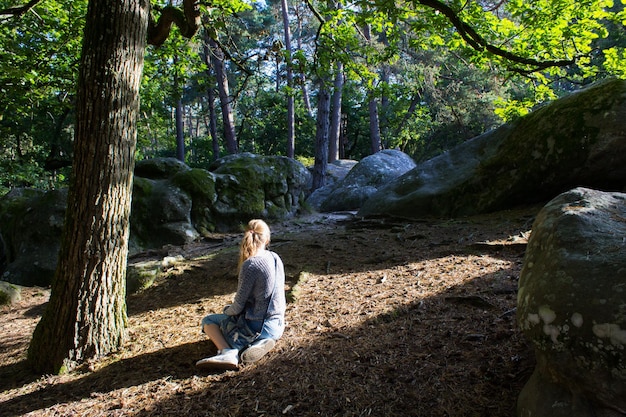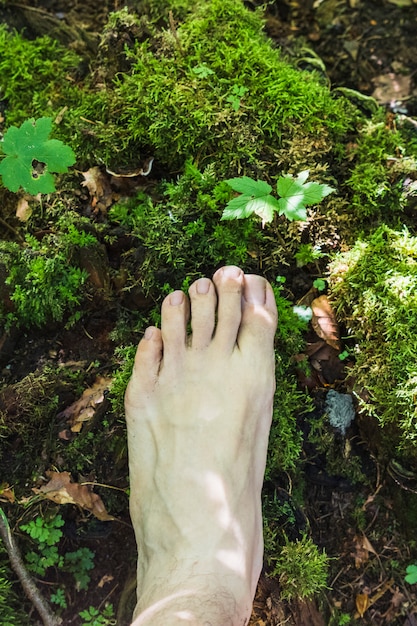Mindfulness and Nature: Reconnect for Well-being in the Natural World

Mindfulness and nature offer a powerful synergy for enhancing well-being and reducing stress by encouraging individuals to intentionally connect with the natural world through practices like mindful walking, nature meditation, and forest bathing, fostering a deeper sense of presence and appreciation.
In today’s fast-paced world, it’s easy to lose touch with the simple joys and restorative power of nature. Discover how mindfulness and nature can work together to enhance your well-being and reduce stress.
The Symbiotic Relationship Between Mindfulness and Nature
Mindfulness and nature, on the surface, might seem like distinct entities. However, when brought together they form a synergistic relationship that can dramatically enhance our mental and emotional well-being. This connection is not just about being physically present in a natural setting, but about actively engaging our senses and cultivating a mindful awareness of our surroundings.
This section explores the profound impact that nature can have on our mental state when approached with mindfulness.
The Restorative Power of Natural Environments
Natural environments possess an innate ability to calm and restore our minds. Studies have shown that spending time in nature can lower stress hormones and improve mood. But what is it about nature that has this transformative effect?
- Sensory Engagement: Nature offers a rich tapestry of sensory experiences, from the rustling of leaves and the chirping of birds to the scent of flowers and the feel of the earth beneath our feet. Engaging with these sensations can help us ground ourselves in the present moment.
- Reduced Mental Fatigue: Unlike the often-demanding stimuli of urban environments, natural settings allow our minds to wander gently, reducing mental fatigue and enhancing our capacity for focus.
- A Sense of Awe: Experiencing the vastness and beauty of nature can inspire a sense of awe, which has been linked to increased feelings of gratitude and a greater sense of connection to something larger than ourselves.
Mindfulness amplifies these natural benefits by encouraging us to fully immerse ourselves in the present experience, without judgment or distraction. By intentionally focusing on the sights, sounds, and sensations of nature, we can deepen our connection to the natural world.
Practical Mindfulness Practices for Connecting with Nature
Incorporating mindfulness into your interactions with nature doesn’t require extensive training or elaborate rituals. Begin with simple practices that allow you to tune in to your surroundings and cultivate a deeper sense of presence. Here are a few practical suggestions to incorporate into your daily life.
These suggestions act as a way to guide you through easy and efficient ways to engage with nature while staying grounded.
Mindful Walking in Nature
Transform your regular walks into mindful experiences by paying close attention to each step. Feel the ground beneath your feet, notice the movement of your body, and observe the landscape around you without getting lost in thought.
Next time you go for a walk, experiment with:
- Slowing Down: Reduce your pace and allow yourself to truly observe your surroundings.
- Focusing on Sensations: Pay attention to the rhythm of your breath and the physical sensations of walking.
- Engaging Your Senses: Notice the colors, textures, and sounds around you.
By bringing mindfulness to your walking practice, you can transform a mundane activity into a powerful opportunity for connecting with nature and cultivating inner peace.

Nature Meditation
Find a quiet spot in nature and settle into a comfortable position. Close your eyes or gaze softly at the landscape. Focus on your breath and allow your thoughts to come and go without judgment. Let the sounds of nature be your guide.
To deepen your experience:
- Listen to the Sounds: Identify the various sounds around you – the wind rustling through the trees, the chirping of birds, the gentle flow of water.
- Feel the Elements: Notice the temperature, the breeze on your skin, the warmth of the sun.
- Engage with the Scent: Inhale deeply and appreciate the natural fragrances around you.
Nature meditation offers a simple yet profound way to cultivate inner stillness and reconnect with the natural world.
In conclusion, by using mindfulness and connecting with nature we are in direct alignment with better well being.
The Science-Backed Benefits of Nature and Mindfulness
The benefits of combining mindfulness and nature extend beyond anecdotal experiences. Scientific research consistently supports the positive impact of these practices on our mental and physical health. Understanding these benefits can further motivate you to incorporate mindfulness and nature into your daily routine.
This section explores the science-backed benefits of engaging nature with mindfulness, including stress reduction, cognitive enhancements, and enhanced emotional well-being.
Stress Reduction and Cortisol Levels
Studies have shown that spending time in nature can significantly reduce stress hormones, such as cortisol. Cortisol is released when the body is under stress, and prolonged elevated levels can lead to a multitude of health problems, including anxiety, depression, and weakened immune function.
Key findings include:
- Reduced Heart Rate: Exposure to natural environments has been linked to lower heart rate, indicating a state of relaxation.
- Decreased Muscle Tension: Spending time in nature can help reduce muscle tension and promote physical relaxation.
- Improved Sleep Quality: Cortisol levels typically decrease during sleep, leading to a more restful and restorative experience.
Mindfulness enhances these benefits by helping you become more aware of your physical sensations and thought patterns, further reducing stress and promoting relaxation.
Cognitive Enhancements: Focus and Creativity
Nature has a remarkable ability to restore our cognitive abilities. Exposure to natural settings can improve focus, enhance creativity, and boost overall cognitive performance.
Benefits include:
- Improved Attention Span: Natural settings provide a quieter, less demanding environment that allows our minds to rest and recover from mental fatigue.
- Enhanced Creativity: Being in nature can inspire creative thinking and problem-solving.
- Increased Cognitive Flexibility: Exposure to nature can improve our ability to switch between tasks and think flexibly.
By combining nature immersion with mindfulness, one can heighten the sense of wonder and awe; connecting one to both inner and outer space.
Overcoming Obstacles to Mindful Nature Connection
Despite the numerous benefits, incorporating mindfulness and nature into our lives can sometimes be challenging. Modern lifestyles, busy schedules, and limited access to natural spaces can create obstacles. However, with a bit of creativity and intention, these challenges can be overcome.
This section addresses common obstacles and provides practical solutions for integrating mindfulness and nature into your daily routine.
Finding Time in a Busy Schedule
One of the most common challenges is finding time to spend in nature. Many people feel that their busy schedules leave little room for activities like mindful walking or nature meditation.
Here are some strategies for overcoming this obstacle:
- Schedule it: Treat your time in nature as an important appointment.
- Incorporate Short Bursts: Even a few minutes of mindful breathing in a park can make a difference.
- Multi-task Mindfully: Combine your commute with a walk through a green space.
Remember, even small moments of connection with nature can have a significant impact on your well-being.
Accessing Natural Spaces in Urban Areas
For those living in urban areas, access to natural spaces can be limited. However, there are often hidden pockets of greenery waiting to be discovered.
Explore:
- Local Parks: Even small city parks can offer a respite from the urban landscape.
- Community Gardens: These spaces provide an opportunity to connect with nature and engage in gardening activities.
- Green Roofs and Balconies: Create your own mini-nature sanctuary in your home.
With a little creativity, urban dwellers can find ways to incorporate nature into their lives and experience its restorative benefits.
With that, finding a way to incorporate a bit of mindful connecting with nature daily can dramatically increase one’s overall wellness.

Creating a Personal Nature Sanctuary
While visiting natural landscapes is beneficial, creating your own personal nature sanctuary can provide a consistent source of calm and rejuvenation. This sanctuary can be as simple as a small indoor garden or a dedicated outdoor space. The key is to create an environment that invites mindfulness and connection with nature.
Consider the following elements in creating and maintaining your nature sanctuary:
Indoor Plants and Greenery
Bringing nature indoors can transform your living space into a calming and restorative environment. Choose plants that appeal to you and that thrive in your indoor conditions.
Ideas for plants:
- Air Purifying Plants: Snake plants, spider plants, and peace lilies are known for their air purifying qualities.
- Aromatic Herbs: Lavender, rosemary, and mint can add a pleasant fragrance to your indoor space.
- Succulents and Cacti: These plants are easy to care for and require minimal maintenance.
Mindfully tending to your indoor plants can become a meditative practice that fosters a deeper connection with nature.
Outdoor Spaces and Gardens
If you have access to an outdoor space, creating a garden or sanctuary can provide endless opportunities for mindful engagement with nature.
Things to consider:
- Design for Sensory Engagement: Incorporate plants with varying textures, scents, and colors.
- Create a Quiet Seating Area: Add a bench or chair where you can sit and observe your surroundings.
- Attract Wildlife: Provide food and shelter for birds, butterflies, and other wildlife.
Your outdoor sanctuary can become a place of refuge where you can reconnect with nature and cultivate inner peace.
Essentially, when your personal space is in alignment with nature, so is your overall well-being!
Integrating Nature and Mindfulness into Daily Life
The true power of mindfulness and nature lies in integrating them into our daily routines. It’s about finding small ways to connect with the natural world and cultivate a mindful presence in our everyday activities. By making nature and mindfulness a consistent part of your life, you’re making a proactive investment in your health.
This section provides practical tips for weaving nature and mindfulness into your daily life.
Mindful Commuting
Transform your commute into a mindful experience by paying attention to your surroundings and engaging your senses.
Ideas to try out:
- Walk or Cycle: If possible, choose a route that takes you through a park or green space.
- Observe Nature: Notice the trees, flowers, and wildlife along your route.
- Practice Gratitude: Take a moment to appreciate the beauty of the natural world.
Mindful commuting turns an otherwise stressful activity into an opportunity for connecting with nature.
Nature-Inspired Breaks
Incorporate short nature-inspired breaks throughout your workday to recharge and reduce stress.
These breaks may include:
- Look at a Plant: Spend a few minutes gazing at a plant and noticing its details.
- Listen to Nature Sounds: Play nature sounds, such as rain or birdsong, in the background.
- Step Outside: Take a short walk in a park or green space.
These small breaks can have a significant impact on your mood and productivity.
In conclusion, just a bit of effort connecting with nature and mindful practices can add up to a life of overall well-being.
| Key Point | Brief Description |
|---|---|
| 🌿 Mindful Walking | Focus on each step, observe surroundings, and engage senses during walks. |
| 🧘 Nature Meditation | Practice meditation in natural settings, focusing on sounds, scents, and sensations. |
| 🌳 Personal Sanctuary | Create a calming natural space indoor or outdoors by mindfully including nature based elements. |
Frequently Asked Questions
▼
Mindfulness in nature involves intentionally focusing your attention on your surroundings, paying attention to the sights, sounds, and sensations of the natural world without judgment or distraction.
▼
Connecting with nature reduces stress hormones, improves mood, enhances cognitive function, and fosters a sense of awe and gratitude, all contributing to better mental health.
▼
Slow down your pace, focus on the physical sensations of walking, and engage your senses to notice the details of your surroundings, such as colors, textures, and sounds.
▼
Utilize local parks, community gardens, green roofs, and balconies to create small pockets of greenery. Incorporate plants, seating areas, and elements that attract birds and butterflies.
▼
If possible, walk or cycle through green spaces. Observe the nature along your route, and take a moment to appreciate the natural beauty around you. Integrate gratitude into your time.
Conclusion
By intentionally practicing mindfulness and nature, you can unlock a powerful source of well-being, reduce stress, enhance cognitive function, and foster a deeper connection with the world around you. Start small, be consistent, and allow the natural world to guide you toward a more mindful and fulfilling life.





